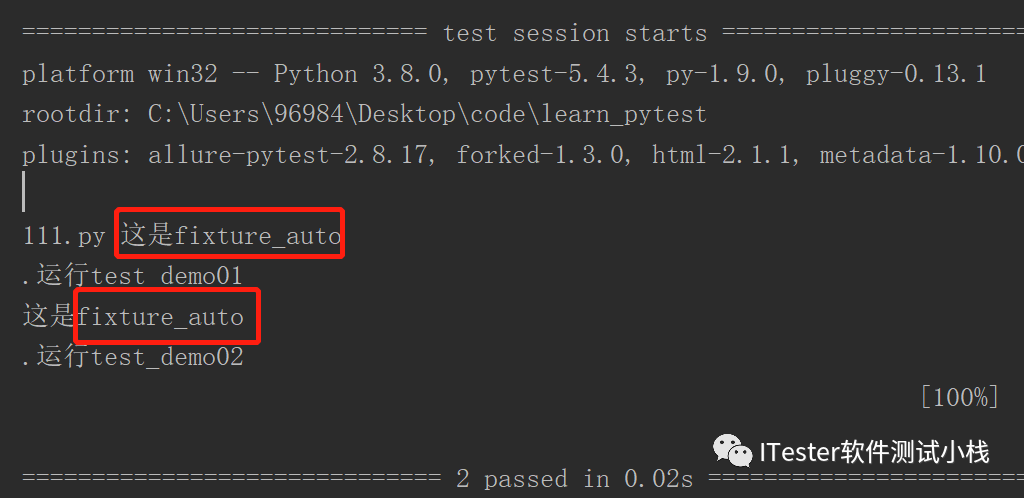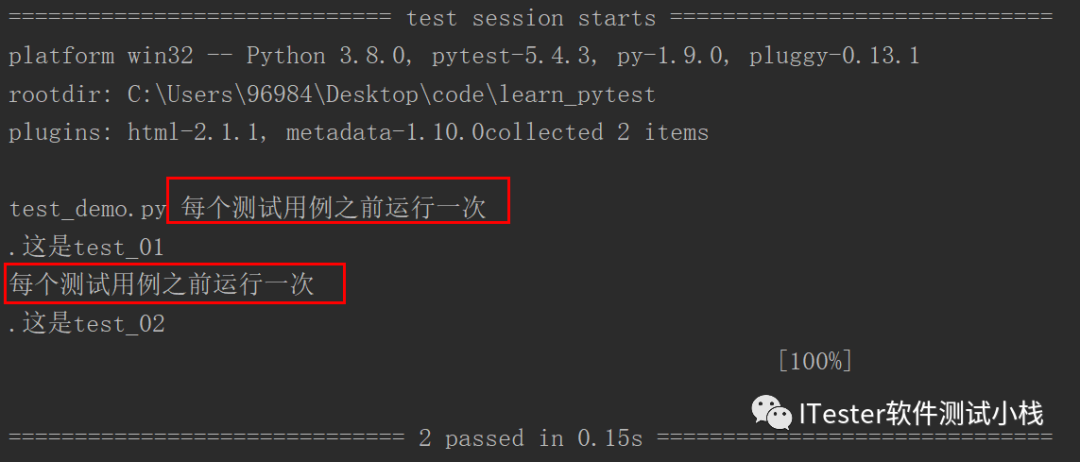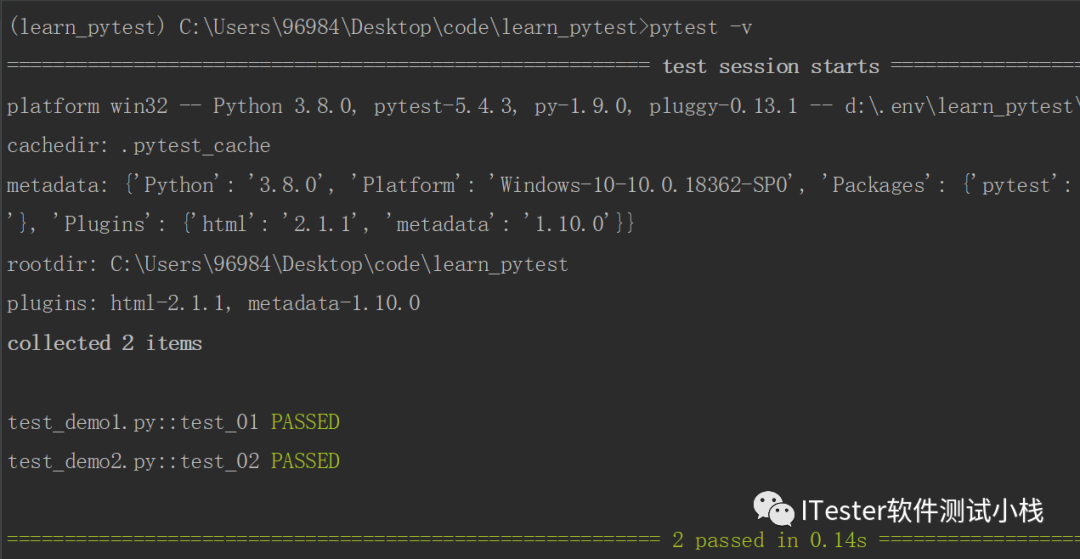Pytest之fixture
共 4583字,需浏览 10分钟
· 2020-08-10

10
2020-08
今天距2021年143天
这是ITester软件测试小栈第148次推文

点击上方蓝字“ITester软件测试小栈“关注我,每周一、三、五早上 07:30准时推送。
微信公众号后台回复“资源”、“测试工具包”领取测试资源,回复“微信群”一起进群打怪。
本文4143字,阅读约需11分钟
fixture基本介绍
fixture是 pytest 用于将测试前后进行预备、清理工作的代码处理机制。fixture相对于unittest中的setup和teardown来说有以下几点优势:
fixure命名更加灵活,局限性比较小;
conftest.py 配置里面可以实现数据共享,不需要import就能自动找到一些配置;
scope="session"可以实现多个.py跨文件使用一个session来完成多个用例。
语法如下:
fixture(callable_or_scope=None, *args, scope="function", params=None, autouse=False, ids=None, name=None)
scope:fixture的作用域,默认为function;
autouse:默认:False,需要用例手动调用该fixture;如果是True,所有作用域内的测试用例都会自动调用该fixture;
name:装饰器的名称,同一模块的fixture相互调用建议写不同的name。
@pytest.fixture即可。@pytest.fixture()
def fixture_demo():
print("这是fixture")
yield区分前后置,即yield前面代码为前置,后面代码为后置。from selenium import webdriver
@pytest.fixture()
def open_browser_init():
# 前置
driver = webdriver.Chrome()
driver.get("https://www.baidu.com")
yield driver
# 后置
driver.quit()
fixture调用
调用fixture的三种方式。
import pytest
from selenium import webdriver
@pytest.fixture()
def open_browser_init():
driver = webdriver.Chrome()
driver.get("https://www.baidu.com")
yield driver
driver.quit()
def test_input(open_browser_init):
open_browser_init.find_element_by_id("kw").send_keys("ITester")
@pytest.mark.usefixtures("fixture名称")。import pytest
from selenium import webdriver
@pytest.fixture()
def open_browser_init():
driver = webdriver.Chrome()
driver.get("https://www.baidu.com")
yield driver #返回driver
driver.quit()
@pytest.mark.usefixtures("open_browser_init")
def test_input(open_browser_init): # fixture名称作为参数传入
open_browser_init.find_element_by_id("kw").send_keys("ITester")
fixture有个参数autouse,默认为False。
autouse为True时,同一个作用域的所有测试用例都会调用这个fixture。
autouse为False时,需要手动调用fixture。
import pytest
@pytest.fixture(autouse=True)
def fixture_auto():
print("这是fixture_auto")
def test_demo01():
print("运行test_demo01")
def test_demo02():
print("运行test_demo02")

fixture作用域
fixture里面有个scope参数可以控制fixture的作用范围,scope参数可以是session, module,class,function, 默认为function。
session 会话级别:是多个文件调用一次,可以跨.py文件调用,每个.py文件就是module;
module 模块级别:模块里所有的用例执行前执行一次module级别的fixture;
class 类级别 :每个类执行前都会执行一次class级别的fixture;
function 函数级别:每个测试用例执行前都会执行一次function级别的fixture。
每个测试用例之前运行一次:
@pytest.fixture()
def test_fixture():
a = "hello"
print("每个测试用例之前运行一次")
yield a
def test_01(test_fixture):
print("这是test_01")
assert "e" in test_fixture
def test_02(test_fixture):
print("这是test_02")
assert "h" in test_fixture
运行结果为:

如果一个class里面有多个用例,都调用了此fixture,那么fixture只在此class里所有用例开始前执行一次。
import pytest
@pytest.fixture(scope="class")
def test_fixture():
a = "hello"
yield a
@pytest.mark.usefixtures("test_fixture")
class TestDemo:
def test_demo01(self,test_fixture):
assert "h" in test_fixture
def test_demo02(self,test_fixture):
assert "o" in test_fixture
运行结果为:

在当前.py脚本里面所有用例开始前只执行一次。
import pytest
@pytest.fixture(scope="module")
def test_fixture():
a = "hello"
print("在当前文件下执行一次")
yield a
def test_01(test_fixture):
print("这是test_01")
assert "e" in test_fixture
@pytest.mark.usefixtures("test_fixture")
class TestDemo:
def test_demo01(self,test_fixture):
print("这是test_demo01")
assert "h" in test_fixture
def test_demo02(self,test_fixture):
print("这是test_demo02")
assert "o" in test_fixture
运行结果为:

session级别是可以跨模块调用的,多个模块下的用例只需调用一次fixture,那就可以设置为scope="session",并且写到conftest.py文件里。
conftest.py作用域:放到项目的根目录下就可以全局调用了,如果放到某个package下,那就在改package内有效。
conftest.py的fixture调用方式,无需导入,直接使用。
conftest.py
import pytest
@pytest.fixture()
def test_fixture():
a = "hello"
print("这是conftest")
yield a
test_demo01.py
def test_01(test_fixture):
print("这是test_01")
assert "e" in test_fixture
test_demo02.py
def test_02(test_fixture):
print("这是test_02")
assert "h" in test_fixture
命令行输入:pytest -v
输出结果如下:



测试交流Q群:727998947

